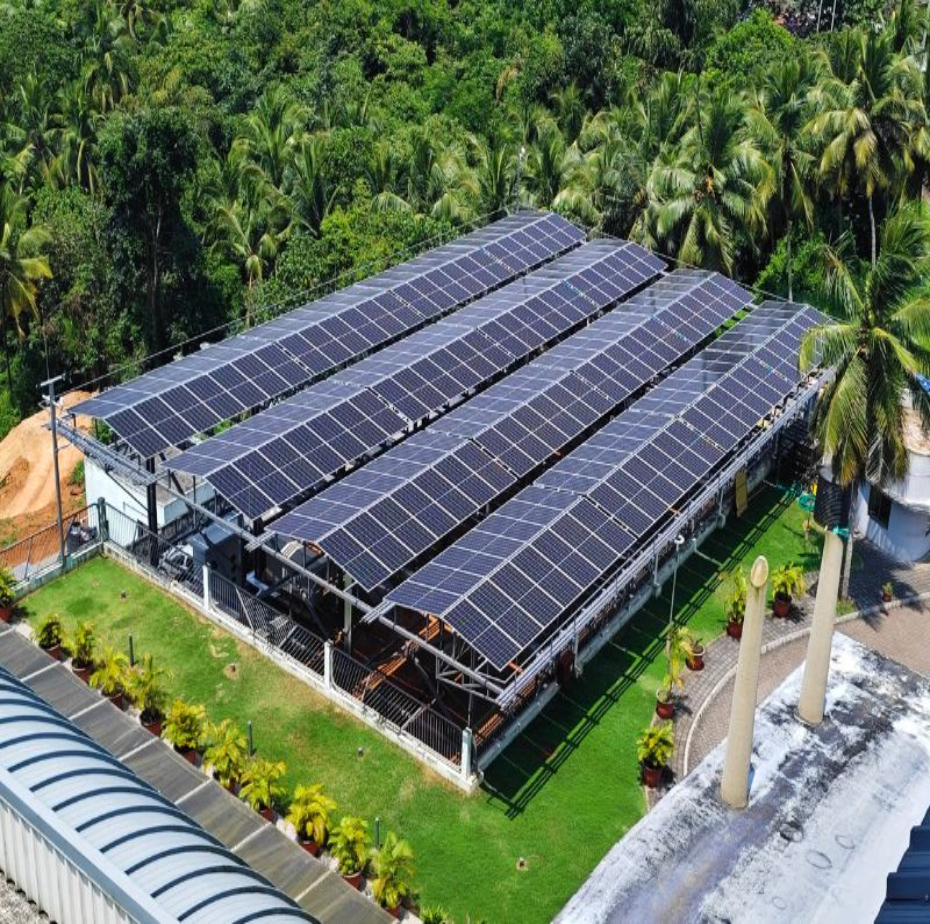




Comparing conventional buildings with green buildings to emphasize the need for sustainable, eco-friendly campus environments. – ASADI (Research and Development Building, Amrita University)
Amrita Vishwa Vidyapeetham has established itself as a pioneer in carbon management and emissions reduction, achieving 65% reduction in Scope 1, 2, and 3 emissions and becoming one of the first universities in India to record campus carbon footprints in real-time. Inspired by Chancellor Sri Mata Amritanandamayi Devi’s vision to reduce carbon emissions, the university is committed to building a climate-positive, carbon-neutral future under its comprehensive “Sustainable Campus Policy”.
Link: https://www.amrita.edu/unsdg-25/sdg7/carbon-reduction-and-emission/

Amrita Vishwa Vidyapeetham Coimbatore campus receiving an award related to green campus certification, highlighting its commitment to sustainability and carbon management.
On November 7, 2023, Amrita Vishwa Vidyapeetham proudly announced its commitment to carbon neutrality by 2030 during the award ceremony where it received the coveted “Platinum” level certification under the Indian Green Building Council (IGBC) Green Campus Rating System. This marks a significant milestone in the university’s journey toward creating a sustainable and eco-friendly educational environment.
The university has developed a comprehensive Net Zero Strategy document outlining its pathway to carbon neutrality, with a focus on reducing emissions across all three scopes through low carbon energy production. As the home to two UNESCO chairs and part of the C20 India 2023 initiative, Amrita has demonstrated global leadership in climate action.
Links:
The university has implemented a thorough, multi-faceted approach to carbon management and CO₂ emissions reduction:

Carbon emission monitoring dashboard showing annual emissions data by scope and category.
Amrita conducts comprehensive assessments of its institutional carbon footprint by quantifying and measuring current CO₂ emissions across all operations. This assessment includes:
The university has become a pioneer by installing real-time carbon footprint dashboards in every building on campus. These dashboards, integrated with MEMS sensors, provide live environmental data and allow students to visualize the environmental impact of their daily activities in classrooms, laboratories, and other campus spaces.
Links:
Amrita University hallway showcasing LED lighting installations for energy efficiency across campus.
The university actively implements energy-efficient practices and technologies to reduce energy consumption and associated CO₂ emissions:
The university has achieved an impressive 30% reduction in grid dependency through its energy efficiency plan.
Links:

Solar panels installed on a rooftop at Amrita University campus generating renewable energy for higher energy efficiency.

Solar panel installation for renewable energy on a campus rooftop, supporsolar-panel-amrita-imageting carbon management efforts.
Amrita is determined to increase the use of renewable energy sources to reduce reliance on fossil fuels and decrease CO₂ emissions:
Large academic buildings are equipped with 306 kWp of rooftop solar PV panels that harness solar power to generate substantial amounts of clean, renewable electricity, significantly reducing reliance on traditional energy sources.
Links:


Four people carpooling in a car, illustrating sustainable transportation to reduce carbon emissions.

Electric vehicle charging station with reserved parking sign on a campus-like setting.
The university actively encourages sustainable transportation options to minimize carbon emissions from commuting and campus transportation:
Carpooling is heavily promoted within the campus, and the university has made significant investments in clean transportation technologies.
Links:
Links:

Outdoor waste bins labeled for compost, recycling, and landfill to support waste segregation and carbon management.

University students actively participating in recycling and composting waste on campus to manage carbon and reduce emissions.
Amrita has implemented effective waste management practices to minimize waste generation and promote recycling, significantly reducing greenhouse gas emissions associated with waste disposal:re
The organic waste collected from Amala Bharatam Campaigns is used to create compost on campus, with food waste, dry leaves, and cow dung combined to produce rich compost in about 90 days. Research has shown that composting food waste instead of sending it to landfills can reduce emissions by the equivalent of up to 6 metric tons of carbon dioxide per metric dry ton of food waste.
Links:
The university prioritizes sustainable design principles in new construction projects and retrofits existing buildings:
Links:
Links:
Lorem ipsum dolor sit amet, consectetur adipiscing elit. Ut elit tellus, luctus nec ullamcorper mattis, pulvinar dapibus leo.
Lorem ipsum dolor sit amet, consectetur adipiscing elit. Ut elit tellus, luctus nec ullamcorper mattis, pulvinar dapibus leo.

Carbon emissions tracker dashboard showing CO2 emissions by category, savings progress, critical emission sources, and recent activity.’
Amrita University has developed SREE (Sustainability & Resilience for Community Engagement & Empowerment) Campus, an advanced Sustainability and Resilience Monitoring Dashboard. This platform:
Students don’t just learn about carbon footprints in theory—they experience it firsthand through state-of-the-art technology displaying real-time data on building dashboards and university TV screens across campus.
Link: https://www.amrita.edu/unsdg-25/sdg13/low-carbon-energy-tracking/

Sustainable Development Goal 13: Climate Action symbol focused on awareness and global environmental protection.
Amrita University has taken significant strides in addressing climate change and fostering sustainable and resilient communities, aligning efforts with global priorities such as the Sustainable Development Goals (SDGs) and commitments discussed at COP28.
Key contributions include:
The university has been ranked 1st in India and 41st globally in sustainable development impact, including 6th globally for SDG 7 – Affordable and Clean Energy.
Links:
In line with the Chancellor’s vision for a sustainable and climate-resilient campus, Amrita University is committed to divesting from carbon-intensive energy industries, particularly coal and oil.
Key initiatives:
This bold step underscores the university’s dedication to reducing energy consumption, minimizing carbon footprint, and driving the transition to clean, renewable energy.
Links:
Amrita conducts extensive research to advance carbon management and climate action:
The School for Sustainable Futures focuses on smart grids, energy-efficient IoT frameworks for energy management, sustainable water-energy nexus solutions, and development of hybrid renewable energy systems.
Links:
The university’s comprehensive carbon management efforts have yielded impressive results:
Links:
Amrita Vishwa Vidyapeetham has received numerous accolades for its carbon management and sustainability efforts:
Links:
Beyond campus operations, Amrita extends its carbon management expertise to communities through student-led programs on energy efficiency and clean energy in villages, promoting agroecology and sustainable agricultural practices to mitigate climate impacts.
The university has executed projects in rural India for electrification through smart grids, including the AmritaSphuranam project providing sustainable solar microgrids to villages without electricity access.
Link: https://www.amrita.edu/unsdg-25/sdg13/climate-action-plan/
Through this comprehensive, multi-faceted approach to carbon management and emissions reduction, Amrita Vishwa Vidyapeetham demonstrates how educational institutions can lead the global transition toward carbon neutrality, achieving measurable environmental impact while inspiring broader community action toward climate resilience and sustainability.